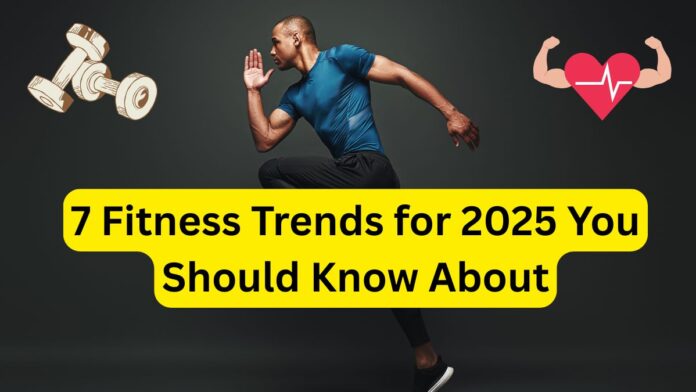The fitness world isn’t standing still—it’s evolving fast. As we move through 2025, we’re seeing powerful shifts in how people approach exercise, recovery, and overall health and wellness. From smarter tech to more inclusive, holistic routines, the focus is less on extremes and more on sustainability, mental health, and personalization.
Whether you’re new to working out or looking to refresh your routine, these fitness trends 2025 will help you stay aligned with what’s current, effective, and most importantly—what works for you.
Best Fitness Trends In 2025
1. Smart Gyms and AI-Powered Workouts
The gym is getting a serious tech upgrade. In 2025, smart fitness equipment is becoming the norm. Think machines that adjust resistance automatically, give real-time feedback on form, and even adapt your workout plan based on previous sessions.
Examples:
- AI-powered platforms like Tonal and Tempo
- Wearables syncing with gym gear to optimize effort and recovery
- Virtual personal trainers using machine learning to customize routines
Why it matters: Efficiency. You get more precise workouts with less guesswork—and fewer injuries.
2. Mental Fitness and Mind-Body Workouts
The line between mental and physical health continues to blur. This year, more people are integrating mindfulness into their exercise routines to support emotional balance as well as strength.
Popular mind-body workout ideas:
- Breathwork-infused yoga
- Meditative strength training
- Tai Chi and mobility flow classes
Apps and studios are offering hybrid classes where meditation meets movement—supporting both body and mind.
3. Wearable Tech That Goes Beyond Step Counting
Wearables in 2025 do a lot more than track your steps. From continuous glucose monitoring to stress level detection, smart watches and fitness bands are now giving deeper insights into overall health and wellness.
New capabilities include:
- Oxygen and respiratory tracking during workouts
- Readiness scores based on sleep, recovery, and heart rate variability
- Real-time hydration reminders and fatigue alerts
Takeaway: The data now goes deeper, helping you train smarter, not harder.
4. Micro Workouts and Exercise Snacking
Gone are the days when you had to carve out a full hour to get fit. Micro workouts—or “exercise snacking”—are becoming the go-to for busy professionals.
How it works:
- Short, high-efficiency workouts (5–15 minutes) spaced throughout the day
- Focused on compound movements like squats, planks, or push-ups
- Easy to do at home or during work breaks
Why it works: It’s practical, time-friendly, and still delivers real fitness gains over time.
5. Inclusive and Adaptive Fitness Programs
Fitness in 2025 is finally becoming more inclusive. Adaptive workout plans designed for people with disabilities, chronic conditions, or different body types are gaining visibility—and respect.
Trends to watch:
- Online platforms offering customizable routines for different mobility levels
- Inclusive group classes and gym layouts
- Trainers specializing in accessible movement and recovery support
Fitness is no longer about looking a certain way. It’s about feeling stronger, regardless of age, size, or ability.
6. Recovery as a Daily Ritual
In 2025, recovery isn’t just something you think about after an injury—it’s part of the routine. People are giving equal attention to how they rest as they do to how they train.
Popular recovery tools:
- Percussion massagers (like Theragun)
- Infrared sauna blankets
- Guided stretching apps
- Cold plunge and contrast therapy sessions
Why it’s trending: Recovery boosts performance, prevents burnout, and supports long-term consistency.
7. Hybrid and On-Demand Fitness Experiences
Thanks to technology, your workout doesn’t have to happen at the gym—or even in your city. The post-pandemic boom in digital fitness continues to evolve with hybrid models.
What’s hot in 2025:
- Livestreamed classes with real-time interaction
- Fitness platforms that blend home workouts with in-gym check-ins
- Personalized video programs with AI feedback
You choose where and how to move, with flexibility that fits your life.
Final Thoughts
Fitness in 2025 is about more than just breaking a sweat. It’s about building habits that last, supporting mental resilience, and embracing tools that make wellness personal and accessible. Whether you’re diving into smart fitness, discovering new workout ideas, or just trying to stay consistent, these trends give you the freedom to shape your routine in a way that feels right for you.
FAQs
Q: Are these fitness trends suitable for beginners?
A: Absolutely. Many of these trends—like micro workouts and mind-body practices—are perfect for beginners because they emphasize accessibility and ease of entry.
Q: Do I need expensive equipment to follow these trends?
A: Not at all. While some tech like smart gyms or recovery tools can enhance your experience, most trends can be adapted using basic or no equipment.
Q: How do I start incorporating mental fitness into my routine?
A: Try adding 5 minutes of breathwork or meditation at the start or end of your workout. Apps like Calm or Headspace can guide you.
Q: What’s the best way to track my progress in 2025?
A: Wearables with deeper health metrics, fitness tracking apps, and AI-assisted platforms make tracking easier than ever—both physically and mentally.
Q: Are recovery-focused trends really necessary if I’m not training hard?
A: Yes. Recovery helps reduce stress, improve sleep, and keep your body in balance—beneficial even for low- to moderate-intensity exercise routines.




